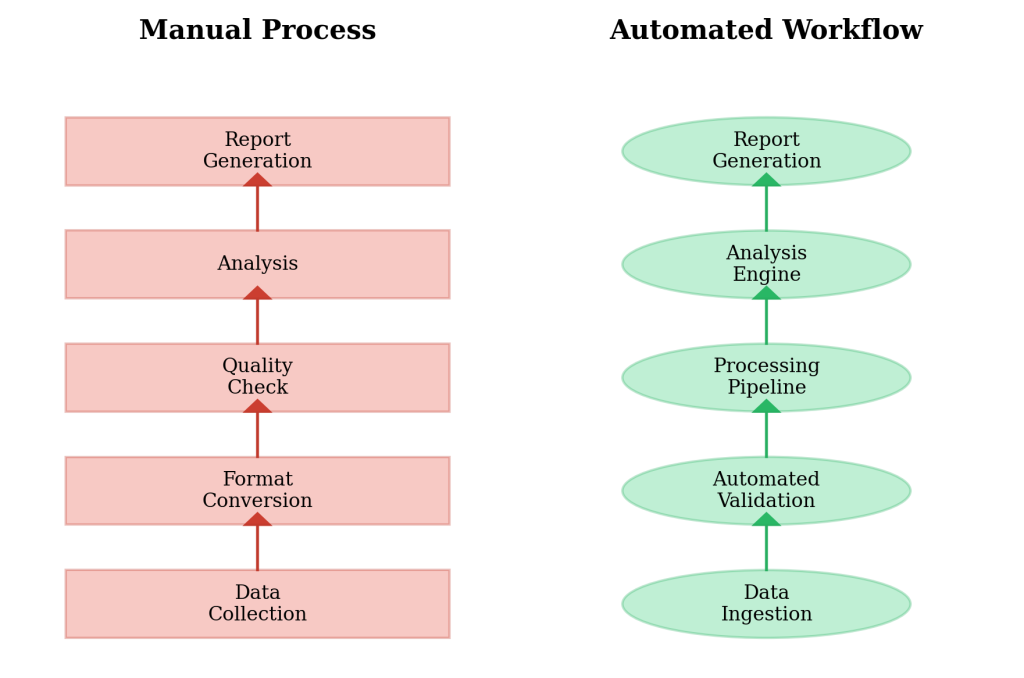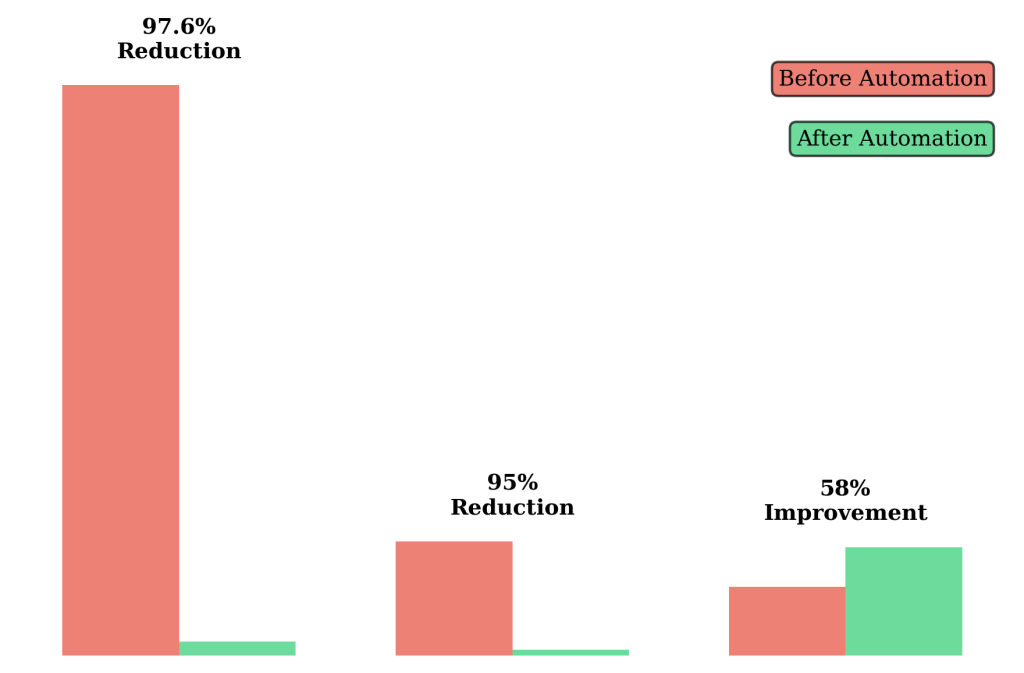Chapter 7.2: Data Workflow Concepts and Automation Benefits
This chapter examines the fundamental principles of automated data processing workflows and their measurable business impact across organizational contexts. Key concepts include the systematic comparison of manual versus automated processing approaches, the role of reproducibility and scalability in enterprise applications, and the implementation of visual programming concepts that democratize workflow automation development.
Manual versus Automated Data Processing Approaches
Manual data processing relies on human operators to perform repetitive tasks including data collection, format conversion, calculation execution, and report generation through sequential steps that require constant attention and quality control oversight. This approach provides flexibility for handling unusual data scenarios and enables immediate decision-making when unexpected situations arise, but suffers from inherent limitations including processing speed constraints, human error susceptibility, and scalability challenges when data volumes increase beyond individual capacity to manage effectively.
Automated data processing transforms manual procedures into systematic workflows where predefined components handle data collection, transformation, analysis, and reporting through interconnected processing steps that execute consistently without human intervention. Automated systems excel at handling large data volumes, maintaining processing consistency, and executing complex calculations accurately, while providing complete audit trails that document every processing decision and transformation applied to source data throughout the analytical pipeline.

Figure 7.2.1: Side-by-side comparison of manual and automated data processing workflows. The manual approach shows sequential human-dependent steps with potential error points and time constraints, while the automated approach demonstrates connected workflow components with standardized processing paths and systematic validation checks.
Fundamental Trade-offs in Processing Approaches
The fundamental trade-offs between manual and automated approaches center on flexibility versus consistency, setup time versus long-term efficiency, and human oversight versus systematic standardization. Manual processes adapt quickly to changing requirements but become increasingly error-prone and time-consuming as data complexity grows, while automated workflows require initial development investment but provide scalable, reproducible processing that maintains quality standards regardless of data volume or processing frequency demands.
Reproducibility, Scalability, and Error Reduction
Reproducible data processing ensures that identical analytical procedures produce consistent results regardless of who executes the analysis or when the processing occurs, supporting scientific rigor and regulatory compliance requirements in industries where audit trails and validation procedures are mandatory. Automated workflows inherently provide reproducibility because they execute identical processing steps each time they run, eliminating variations introduced by different analysts applying subjective judgment or making transcription errors during manual data handling procedures.
Scalability benefits emerge when automated workflows can handle increasing data volumes, additional data sources, or more frequent processing requirements without proportional increases in human effort or processing time. Visual workflow systems enable scalability by allowing analysts to modify processing parameters, add new data sources, or increase processing frequency through configuration changes rather than rebuilding entire analytical procedures, supporting business growth and evolving analytical requirements over time.
Error reduction through standardized processes occurs because automated workflows eliminate common sources of human error including data transcription mistakes, calculation errors, format inconsistencies, and missed processing steps that frequently occur in manual procedures. Systematic validation rules, data quality checks, and exception handling built into automated workflows detect and manage data quality issues consistently, ensuring that downstream analysis receives clean, properly formatted data that meets predefined quality standards essential for reliable analytical results.
Industrial Implementation: Siemens Electronics Factory Case
Siemens Electronics Factory in Amberg, Germany demonstrated the transformative potential of automated workflow implementation in high-volume manufacturing environments. The facility, which manufactures over 16 million automation controllers annually, faced critical operational challenges when demand surged while quality standards became increasingly stringent. Manufacturing Director Klaus Weber and Senior Process Engineer Dr. Andrea Nilsen led a comprehensive automation transformation that revolutionized quality control operations across the facility.
The automation transformation centered on implementing comprehensive data workflow systems to replace manual inspection processes that consumed significant labor hours while introducing human errors in detecting microscopic defects on printed circuit boards and electronic components. Dr. Nilsen designed automated visual inspection systems that collected high-resolution images from production equipment, applied machine learning algorithms for defect detection, and generated real-time quality alerts when measurements exceeded tolerance specifications.
Workflow Architecture Implementation
The automated system utilized visual programming concepts where each data processing step was represented as connected components in integrated workflow pipelines that eliminated manual transcription errors while maintaining regulatory compliance requirements for industrial manufacturing standards. The automated workflows began with data collection nodes that gathered sensor measurements and visual data from production equipment every few seconds, followed by data validation components that checked for sensor malfunctions or image quality issues.
Statistical analysis modules calculated control chart parameters and identified trend patterns that predicted potential quality issues before defective controllers were produced. Alert generation components automatically notified supervisors when processes required attention, while reporting modules created standardized documentation for ISO 9001 compliance audits and customer quality requirements.

Figure 7.2.2: Quantified business impact metrics from the Siemens Electronics Factory automation implementation. The visualization demonstrates the dramatic reduction in manufacturing faults from 500 DPM to 12 DPM, representing a 97.6% improvement in quality performance alongside processing time reductions and accuracy enhancements.
Within two years of full implementation, Siemens Electronics Factory’s quality control automation achieved remarkable results documented in peer-reviewed research publications. The automated workflows reduced manufacturing faults from 500 errors per million actions (DPM) to just 12 DPM, representing a 97.6% improvement in quality performance (Nilsen & Nyberg, 2021). Quality control processing time decreased from several hours of manual inspection to continuous real-time monitoring, while defect detection accuracy improved by over 95% compared to manual inspection methods.
Business Impact Assessment and Visual Programming
Business impact assessment for workflow automation requires systematic evaluation of cost-benefit relationships including development time investment, training requirements, maintenance needs, and expected returns through improved efficiency, accuracy, and scalability that support organizational objectives. Successful automation projects typically demonstrate measurable improvements in processing time, error reduction, compliance capabilities, and resource allocation that enable staff to focus on higher-value analytical tasks rather than repetitive data processing activities.
Visual Programming Philosophy
Visual programming concepts provide accessible approaches to workflow automation by representing data processing steps as graphical components that can be connected through drag-and-drop interfaces rather than requiring traditional programming languages that demand specialized technical expertise. This visual approach democratizes automation development by enabling domain experts who understand business requirements to create and modify workflows without depending on programming specialists, reducing development time and improving alignment between automated processes and business needs.
KNIME Analytics Platform Methodology
KNIME Analytics Platform exemplifies visual programming philosophy through its node-based workflow design where each processing task is represented as a configurable component that connects to other components through data flow connections. This approach enables analysts to build sophisticated data processing pipelines by combining pre-built nodes for data reading, transformation, analysis, and output generation, creating reproducible workflows that can be documented, shared, and maintained by team members with different technical backgrounds and expertise levels.
The platform’s visual programming approach reduces technical barriers to workflow automation by providing drag-and-drop interfaces that represent complex data processing operations as intuitive graphical elements. Node-based workflows support collaborative development because team members can understand, modify, and extend automated processes without requiring deep programming knowledge, improving alignment between business requirements and technical implementation while reducing development time and maintenance complexity.
Cross-Industry Applications
Healthcare organizations implement automated workflows to process patient test results, update medical records, and generate treatment recommendations. Automated systems ensure accurate, timely patient care while maintaining compliance with healthcare regulations, replacing manual transcription processes that were time-consuming and error-prone in critical care environments.
Electronics and automotive manufacturers utilize automated inspection systems that photograph products, detect defects using computer vision, and generate quality reports. These systems replace manual inspection procedures that missed microscopic defects while consuming significant labor resources, improving product quality while reducing inspection costs and processing time.
Retail organizations employ automated systems to track sales transactions, update inventory levels, and trigger reorder processes when stock reaches predetermined thresholds. This automation eliminates manual counting procedures and prevents stockouts or overordering that occur when employees manually track thousands of products across multiple locations.
Financial institutions automate fraud detection, loan approval processes, and regulatory reporting requirements. Automated workflows analyze transaction patterns, verify customer information, and generate compliance reports, reducing processing time from days to minutes while improving accuracy and regulatory compliance capabilities.
Key Concepts Summary
Automated data processing workflows provide systematic approaches to handling repetitive analytical tasks while maintaining consistency, accuracy, and scalability that manual processes cannot achieve at enterprise scale. The fundamental transition from manual to automated processing requires careful evaluation of business requirements, technical capabilities, and organizational readiness to support successful implementation.
Visual programming concepts democratize workflow automation development by enabling domain experts to create sophisticated data processing pipelines without traditional programming expertise. This accessibility supports broader organizational adoption of automation technologies while improving alignment between business requirements and technical implementation.
Reproducibility, scalability, and error reduction represent the core benefits that justify automation investment in enterprise environments. These benefits support regulatory compliance, business growth, and operational efficiency improvements that create sustainable competitive advantages in data-intensive industries.
References
Adhikari, A., DeNero, J., & Wagner, D. (2022). Computational and Inferential Thinking: The Foundations of Data Science (2nd ed.). University of California, Berkeley.
KNIME AG. (2024). KNIME Analytics Platform: Visual workflow development and automation. KNIME AG.
Nilsen, A., & Nyberg, A. (2021). Intelligent manufacturing in the context of industry 4.0: A case study of Siemens industry. Research Papers Faculty of Materials Science and Technology Slovak University of Technology. https://doi.org/10.13140/RG.2.2.23423.82309
Siemens AG. (2024). Manufacturing quality: Closed-loop quality management systems. Siemens Digital Industries Software.
Timbers, T., Campbell, T., & Lee, M. (2024). Data Science: A First Introduction. University of British Columbia.

